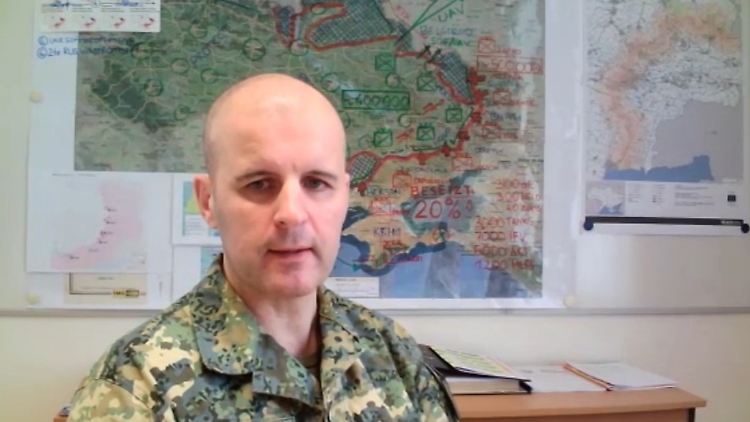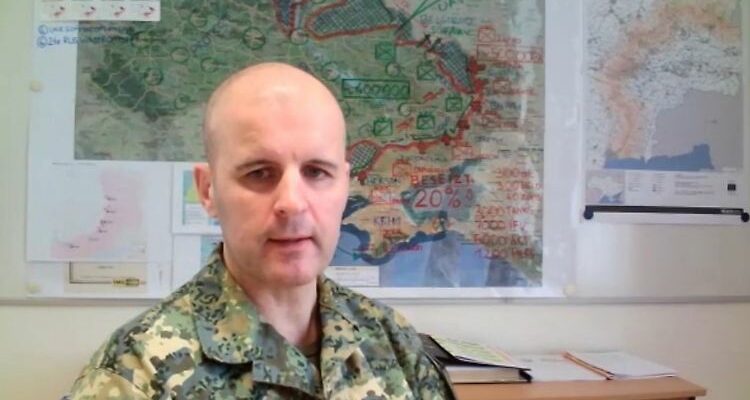With drone attacks and border crossings by the Russian Legion, Ukraine tried to distract from the difficult situation at the front during the Russian presidential elections, says Colonel Markus Reisner in the weekly look at the situation in Ukraine. However, drone attacks in particular also have a strategic side. Regarding the presidential election in Russia, Reisner says: “One can assume that Putin, with almost 90 percent approval, will have a new spring offensive prepared.”

Markus Reisner is a colonel in the Austrian armed forces and analyzes the war situation in Ukraine every Monday for ntv.de.
ntv.de: You recently warned of a Russian breakthrough. How has the front developed in the last few days?
Markus Reisner: Let’s start at the tactical level. Here you can see that Russia is still trying to exert massive pressure in a total of 18 places in order to be able to advance deeper behind the front. Especially in the Avdiivka area, the Russians are trying to break through Ukraine’s second line of defense, which, however, still holds.
Why?
Because Ukraine has managed to continually bring in new reserves and forces in the past few days. They prevented the Russians from breaking through here.
At the operational level, one can see that the Russians are trying to achieve some results before the first muddy period of the year, the so-called Rasputitsa, which is about to begin. Therefore, one can say that the second Russian winter offensive is obviously close to its climax. Overall, five main directions can be identified: in the Donetsk region, firstly, northeast of Slovyansk in the area of the town of Torske. Secondly west of Bakhmut, thirdly west of Avdiivka and fourthly south of Novomykhailivka. And finally in the Zaporizhia region between Robotyne and Werbowe. The background to the massive attacks was undoubtedly to maintain pressure on Ukraine during the presidential election in Russia.
Ukraine carried out more drone strikes on Russia during the election than ever before.
That was one of two elements to counteract this in the information space. But the attacks also have a strategic side. Russia has about 30 large refineries. In recent weeks, Ukraine appears to have managed to attack at least twelve of them, some repeatedly, and to severely damage some.
Do these attacks have a practical effect?
We will see that in the next few weeks and months. It is assumed that around 10 to 15 percent of the Russian Federation’s refining potential was hit. There are observers who link the fuel rationing imposed in Russia with the drone attacks on refineries. This is not only a propaganda success, but from my point of view it also manages to hit the Russians hard in some areas. For the Russians, the attacks obviously mean that they have to use anti-aircraft systems to protect the refineries. And these systems are then no longer available at the front. This may be part of Ukraine’s forward-looking preparation for the use of the F-16 fighter jets, which are to be deployed in Ukraine in the near future.
You spoke of two elements to counter the Russian successes on the front in the information space.
The second element is the attempt to cross into Russian territory in four places, not by Ukrainian forces, according to the Ukrainian narrative, but by so-called Russian volunteer associations, the Russian “Russian Freedom Legion”. Ukraine is also trying to divert attention from the difficult situation at the front. We already saw something like this after the fall of Bakhmut, in May 2023.
Aren’t these border crossings pretty much suicide missions?
These commandos are equipped with Western weapons by Ukraine, and Ukrainian soldiers are also involved. And Russia, of course, needs some time to react to this, that is, to bring in forces. This usually takes two or three days. But then massive counterattacks occur. In most cases this actually leads to massive losses for the attacking commandos. The push after the fall of Bakhmut last year truly became a suicide mission. But it served its purpose, because no one talked about the defeat at Bakhmut anymore.
Is the Ukrainian weakness that we are currently observing due to the lack of arms and ammunition deliveries from the West?
You can actually say that. On the one hand, the ammunition situation at the tactical-operational level remains precarious. There are now dozens of reports here that show that Ukraine cannot fire back with artillery in the same way that the Russians do. But there are also deficiencies in the important area of anti-aircraft ammunition. It is assumed that there will be a massive cut in the available anti-aircraft ammunition by the end of March. This particularly applies to surface-to-air missiles, which are needed to shoot down incoming targets. In the worst case scenario, only every fifth incoming target – whether cruise missile or Iranian drone – can be shot at. This shows how much Ukraine’s defense capability depends on the availability of external resources.
Last week, Chancellor Olaf Scholz said in the Bundestag that the question now is, “How do we manage to deliver weapons and ammunition that reach further than fifty or eighty or a hundred kilometers, because that is the area in which which is essentially what it’s about.” Is a hundred kilometers really enough?
To do this, you have to understand the structure of the attacker. We have an immediate close range of thirty to fifty kilometers behind the front. This is the area in which the immediate supply and management of forces takes place. Since Ukraine has had the American HIMARS systems, the Russians have had to move this area back because the HIMARS operate at a distance of up to seventy kilometers. Behind this distance you can now find the logistics, but also the local command structures of the Russian armed forces. That’s why the range up to a hundred kilometers is of great importance. With weapon systems that are so effective, you can target the large ammunition depots and, above all, the command structure. However, such attacks only work with a high repetition rate. This is the only way to achieve a sustainable wear or oversaturation effect. Only then can one assume that the enemy will experience measurable restrictions, i.e. a virtual cessation of attacks along the front. So far this is not apparent. But the discussion goes exactly in this direction.
Olexander Syrskyj, the successor to the popular army commander Valeriy Zalushnyj, will soon be in office for six weeks, and in the wake of his appointment there has been an even further realignment at the top of the Ukrainian army. Do you already recognize the effects of these personnel decisions?
General Syrskyj pointed out at the end of last year that for the benefit of the soldiers it was necessary to abandon certain sections of terrain and return to areas that were easier to defend. You can see this not least at Avdiivka. Syrsky also managed to supply the section commanders with reserves and resources to such an extent that the Russians were unable to make a significant breakthrough in their second winter offensive. There are intrusions along the areas described, but no operational breakthrough. That’s a good sign. Syrskyj at least managed to keep the front stable up to Rasputitsa.
As expected, Kremlin leader Putin has been re-elected. How do you assess Putin’s role as commander-in-chief, which he has confirmed himself to be for the next six years?
It can be assumed that Putin, with almost 90 percent approval, will have a new spring offensive prepared. According to our Western understanding, the election was not free, but it is clear that the president’s popularity is high. With their propaganda, Putin and his entourage manage to convince the majority of Russians that this is a kind of Great Patriotic War 2.0: a fight for survival by the Russian people.
After his re-election, Putin claimed in a speech that he was open to the idea of a ceasefire during the Olympics. At the same time, he said that the interests of the Russian military at the front must be taken into account. Last week, Putin said on Russian television: “Starting negotiations now just because Ukraine is running out of ammunition would be ridiculous.” What kind of message is contained in these statements?
I think that the Russian President wants to make it very clear to his people that he is following this path to the end. For him, the goal continues to be the conquest – in his view, the retrieval – of Ukrainian territory. Especially now, as the West’s material support is waning, Russia realizes that it can play for time to achieve its goal. The fact that the losses are very high, both in terms of people and resources, obviously doesn’t matter to the Russian side.
In Odessa, at least 20 people were killed in Russian rocket attacks, including medics and other rescuers who rushed to the site of the impact because a rocket had already struck there. Isn’t this what terrorists do: attract helpers with an attack, then detonate another bomb?
During the Second World War, the Allies repeatedly dropped bombs with a timer so that they could cause the greatest possible damage. We see a similar approach here too. This starts with Russia attacking Ukrainian territory almost every day with Iranian drones. This means that there are air alarms several times a day. People are woken from their sleep and practically cannot rest. If you have to experience this for months, then it does something to you. Secondly, the purpose of using the Shahed drones is to test the defensive capabilities of the Ukrainian air defense system. This is usually followed by a targeted attack with cruise missiles based on the detected system fourteen days to three weeks later, usually supported by another wave of Iranian drones.
Russian Defense Minister Shoigu visited the Black Sea Fleet on Sunday and said daily training was needed “on how to repel attacks from the air and from unmanned boats.” Is this an indirect admission that Ukraine poses a threat to the Russian Navy?
That’s how I would see it. In fact, Ukraine has managed to push the Black Sea Fleet back from the western Black Sea – primarily through the use of unmanned surface and underwater systems. The ships of the Russian Black Sea Fleet that were not sunk are now off the southern Russian coast and are more or less doomed to do nothing. This is also a success for Ukraine because some of these ships were involved in the airstrikes. However, the bulk of the air strikes come from the air, from bombers that do not have to fly into Ukrainian airspace, but fire their rockets or cruise missiles from Belarusian or Russian airspace.
But there are two interesting aspects here: Firstly, the leadership of the Black Sea Fleet was replaced, apparently because of the losses. And second, Shoigu’s visit should show that he expects improvement in this skill area. Although I’m not sure whether the Russians have found an answer here yet.
Hubertus Volmer spoke to Markus Reisner
